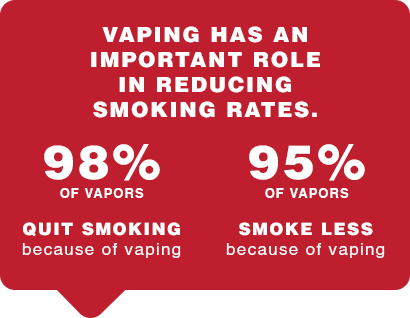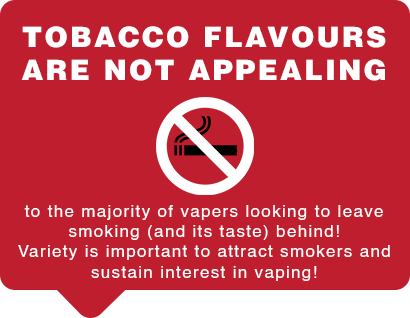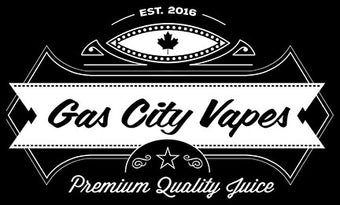Vaping at a Crossroads 2024: Navigating Canada's Potential E-Liquid Flavour Ban
In the heart of Canada's bustling cities and quiet towns, vape shops stand as beacons of change for those seeking an alternative to smoking. These shops offer a plethora of e-liquid flavours, from the rich aroma of coffee blends to the sweet zest of berry concoctions, providing a unique experience that has helped countless individuals transition away from traditional cigarettes. However, this beacon of hope now flickers in the shadow of potential regulatory changes. The Canadian government is considering a ban on a wide array of e-liquid flavours, aiming to curb vaping's appeal to the youth. This move, though well-intentioned, could have far-reaching implications not just for vapers but for the entire vaping industry and the public health goals it supports.
Section 1: The Role of Flavours in Smoking Cessation
The journey from smoking to quitting is fraught with challenges, temptations, and setbacks. For many, the transition to vaping has been a beacon of hope, largely due to the availability of a wide range of e-liquid flavours. This diversity not only enhances the appeal of vaping as a cessation tool but also plays a pivotal role in its effectiveness. In this section, we delve into the crucial role that flavours play in smoking cessation, supported by statistics and evidence that underscore their importance.
The Appeal of Flavoured E-Liquids
Flavoured e-liquids have fundamentally changed the landscape of smoking cessation. Unlike traditional nicotine replacement therapies (NRTs) such as patches or gum, vaping offers a sensory experience that mirrors the act of smoking but with significantly reduced health risks. The variety of flavours available has been instrumental in attracting smokers who are seeking an alternative that doesn't feel like a medical treatment but rather a lifestyle change they can enjoy and sustain.
Statistical Evidence on Efficacy
A growing body of research supports the efficacy of vaping as a smoking cessation tool. A landmark study published in the New England Journal of Medicine found that e-cigarettes were nearly twice as effective as traditional NRTs in helping smokers quit. Within this context, flavours play an essential role. Surveys conducted within the vaping community indicate that a majority of ex-smokers credit flavoured e-liquids with helping them reduce or completely quit smoking. Furthermore, research suggests that adult vapers have a preference for non-tobacco flavours, indicating that these flavours are crucial in the transition away from the taste of tobacco.
Debunking the Myth: Flavours and Youth Vaping
One of the primary arguments for banning flavoured e-liquids is the concern that they target youth. However, this perspective overlooks crucial data. Studies indicate that while flavours are indeed appealing to youth, they are not the main driver behind youth experimentation with vaping. Factors such as curiosity, peer influence, and the perceived harm reduction compared to smoking play a more significant role. Importantly, imposing a flavour ban could inadvertently harm adult smokers seeking a viable pathway to quit smoking, without effectively addressing the root causes of youth vaping.
The Role of Flavours in Long-term Abstinence
The transition from smoking to vaping is not a one-time event but a journey that requires sustained effort and support. Flavoured e-liquids are a key factor in this long-term transition, helping ex-smokers stay away from cigarettes. The variety of flavours keeps the vaping experience enjoyable and engaging, reducing the temptation to revert to smoking. For many, the ability to choose and switch between flavours is crucial in maintaining their smoke-free status, highlighting the importance of preserving these options for adult vapers.
Section 2: Impact on Vapers
The potential ban on flavoured e-liquids in Canada casts a long shadow over the vaping community, threatening to dismantle a crucial support system for countless individuals who have turned to vaping as a means to quit smoking. This section explores the tangible and psychological impacts that such a ban would have on vapers, highlighting personal stories and examining the broader implications for those who have found solace and success in vaping.

Rights4Vapors survey results 2022
The Psychological Impact of Removing Flavours
The removal of flavoured e-liquids threatens more than just a business model; it risks dismantling a critical psychological support for those who have used vaping as a stepping stone away from smoking. The act of vaping, coupled with the enjoyment of specific flavours, creates a routine and a sensory experience that many rely on to fend off the urge to return to smoking. This psychological aspect is often overlooked in policy discussions. Without access to flavoured e-liquids, the monotony of tobacco-flavoured alternatives may not suffice to keep former smokers away from cigarettes, potentially unraveling their hard-won progress.
The Risk of Relapse and Unregulated Alternatives
One of the most significant concerns surrounding the flavour ban is the potential for relapse among former smokers. The allure of returning to smoking becomes considerably stronger when the preferred, safer alternative is stripped of its appeal. Furthermore, there is a real danger that a flavour ban could push vapers towards the black market, seeking unregulated and possibly unsafe flavoured e-liquids. This not only poses a direct risk to individual health but also undermines the regulatory progress made in ensuring that vaping products meet safety standards.
Navigating the Ban: Adaptation and Resistance
Faced with the possibility of a flavour ban, many vapers are already considering how they might adapt. Some discuss the potential for DIY mixing, while others speak of stockpiling their favourite flavours. However, these are not solutions but mere stopgaps that highlight the desperation of those who feel their successful quit-smoking strategy is being threatened. The vaping community has also rallied, advocating for sensible regulations that protect youth without disadvantaging adult smokers who have benefited from vaping.

Rights4Vapors survey results 2022
Section 3: Consequences for Local Vape Shops and the Industry
The implications of a potential e-liquid flavour ban extend beyond individual vapers, posing a significant threat to local vape shops and the broader vaping industry in Canada. This section examines the economic impact, the potential loss of jobs, and the broader implications for the industry that has grown around vaping, highlighting the vital role these businesses play in communities and the economy at large.
Economic Impact on Local Businesses
Local vape shops have been cornerstones in the vaping community, offering more than just products; they provide expert advice, support for those looking to quit smoking, and a sense of community. A ban on flavoured e-liquids would hit these small businesses hard, stripping them of their most popular and profitable products. For many shops, the sale of flavoured e-liquids constitutes a significant portion of their revenue. The loss of these products could lead to reduced foot traffic, decreased sales, and ultimately, closures. The ripple effect on suppliers, manufacturers, and other stakeholders in the vaping ecosystem would exacerbate the economic fallout, leading to a contraction of the industry as a whole.
Job Losses and Economic Contraction
The vaping industry is a significant employer, from retail employees in vape shops to those involved in the production and distribution of vaping products. A flavour ban threatens these jobs, potentially leading to widespread layoffs and unemployment in a sector that has been a source of innovation and growth. The economic contraction would not be limited to the vaping industry alone; it would also impact related sectors such as advertising, manufacturing, and logistics. At a time when economic stability is paramount, such a move could have far-reaching consequences for the Canadian economy.
Broader Implications for the Vaping Industry
Beyond the immediate economic impacts, a flavour ban would have profound implications for the future of the vaping industry in Canada. It would stifle innovation and discourage investment in a market perceived as increasingly volatile and regulated. Furthermore, it would shift the competitive landscape, potentially favouring larger tobacco companies that can absorb the impact more easily than small businesses. This could lead to decreased diversity in the market, with fewer choices for consumers and a potential increase in prices for remaining products. Additionally, the ban could set a precedent for further restrictive regulations, casting a shadow of uncertainty over the future of vaping in Canada.
The Role of Vape Shops in Smoking Cessation
It's essential to acknowledge the role that vape shops play in smoking cessation efforts. These businesses are not merely retail outlets but support centers for individuals looking to quit smoking. Staff often provide advice on quitting, share personal success stories, and create a supportive community for customers. By offering a range of flavoured e-liquids, they help make the transition away from smoking more manageable and enjoyable. The potential closure of these shops would not only be an economic loss but a blow to public health efforts aimed at reducing smoking rates.
Section 4: Arguments Against the Ban and Alternative Solutions
The debate over the proposed e-liquid flavour ban in Canada is multifaceted, with significant concerns raised about its potential impacts on adult vapers, local businesses, and broader smoking cessation efforts. This section outlines the primary arguments against the ban and proposes alternative solutions that could address public health concerns without negating the benefits that flavoured e-liquids offer to adult smokers looking to quit.

Rights4Vapors survey results 2022
The Flaw in the Argument for a Ban
A central argument for the flavour ban is its potential to reduce youth vaping. However, this perspective may not fully account for the complexity of the issue. Critics of the ban argue that it punishes adult smokers who rely on flavoured e-liquids as a cessation tool, without adequately addressing the root causes of youth vaping. Moreover, evidence suggests that factors like peer influence, accessibility, and the allure of experimenting with forbidden substances play a more significant role in youth vaping than the availability of flavours alone. Thus, a flavour ban might not achieve its intended effect but could instead drive both youth and adults towards unregulated markets, posing greater risks.
Evidence from Other Jurisdictions
Looking at other jurisdictions that have implemented similar bans provides valuable insights. In some cases, such bans have not led to a significant decrease in youth vaping rates but have negatively impacted adult vapers and the vaping industry. For instance, studies from certain U.S. states show that flavour bans have led to increased cross-border purchases, a rise in black market sales, and no substantial decline in youth vaping rates. These outcomes suggest that a more nuanced approach might be necessary to effectively address the issue.
Alternative Solutions
Given the potential downsides of a flavour ban, several alternative strategies could be more effective in preventing youth vaping while preserving the benefits for adult smokers. These include:
- Enhanced Enforcement of Existing Laws: Strengthening the enforcement of current regulations that prohibit the sale of vaping products to minors could deter underage vaping more effectively than banning flavours.
- Targeted Education and Prevention Programs: Investing in comprehensive education programs that inform youth about the risks of vaping and nicotine addiction could help reduce experimentation and usage.
- Access Control Measures: Limiting the sale of flavoured e-liquids to adult-only venues, such as vape shops, could reduce accessibility for youth while allowing adults to continue using these products for cessation.
The Way Forward: A Balanced Approach
The discussion around the flavour ban highlights the need for a balanced approach that considers the interests and health of all Canadians. By focusing on targeted measures that specifically address youth vaping without unduly impacting adults who have successfully transitioned away from smoking, it's possible to protect public health while supporting smoking cessation efforts. This approach requires collaboration between policymakers, public health experts, the vaping industry, and the community to develop effective, evidence-based strategies.
Conclusion
The debate over the potential ban on flavoured e-liquids in Canada is a complex issue that sits at the intersection of public health, individual freedom, and economic interests. While the intention behind the ban—to reduce youth vaping—is commendable, the potential consequences for adult vapers, local vape shops, and the broader smoking cessation landscape cannot be ignored. This blog post has argued that flavours play a critical role in helping adult smokers transition to a less harmful alternative and that a ban could undermine this progress.
As we consider the way forward, it is crucial that any action taken is informed by evidence, considers the experiences of those directly impacted, and seeks to balance public health goals with the needs of adult smokers who have found an effective cessation tool in vaping. Alternative strategies, such as stricter enforcement of existing laws, targeted education programs, and access control measures, offer a path forward that addresses the concerns of youth vaping without sacrificing the benefits gained by adult ex-smokers.
The vaping community, industry stakeholders, and public health officials must come together to chart a course that protects the health of Canadians in all their diversity. By adopting a nuanced approach that recognizes the complexities of vaping and nicotine addiction, we can work towards a solution that supports public health objectives while respecting the choices and needs of adult smokers looking to quit.
Call to Action:
We encourage readers to engage in this critical conversation by educating themselves on the issue, sharing their stories, and participating in consultations and dialogues that shape the future of vaping in Canada. Together, we can find a balanced solution that protects the health of young Canadians while supporting those who are on a journey to quit smoking.



